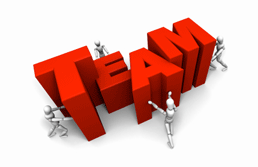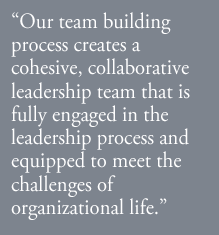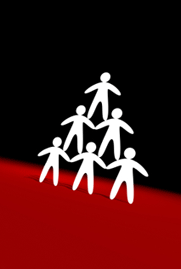
![]()
A high-performing leadership team is the foundation of a successful organization. For a team to be maximally effective, members must function on a collective as well as on an individual basis. They must be dedicated to the group's goals, its shared work products and  performance results, and committed to the success of each individual member.
performance results, and committed to the success of each individual member.
Our team building process creates a cohesive, collaborative leadership team that is fully engaged in the leadership process and equipped to meet the challenges of organizational life. We guide team members to foster an environment where they practice the organization’s values and standards and share accountability for results, while we provide the team leader with the necessary tools to drive the development process.
![]()
The key objective of our team building process is to engage senior staff in the development of a unified team whose members:

- Share an understanding of the organization's vision and goals
- Embrace common commitments in alignment with those of the organization
- Clearly identify individual and collective leadership roles to realize the vision
- Determine and adopt standards of behavior consistent with achieving the goals
- Model these standards in their attitudes, actions, and communications
- Manage their departments by these standards
- Agree on processes for setting priorities, making and implementing decisions, solving problems, and resolving conflicts
- Identify and address issues that impede optimal functioning
![]()
While there is no single approach to team building, the process usually incorporates a number of steps centered on a developmental team meeting, or series of meetings:

Initial Consultation: In our initial meetings with the project sponsor and key stakeholders, we learn about the project objectives, scope, and any organizational issues the client may be facing. We develop a project plan that clearly establishes mutual expectations.
Data Gathering: We conduct confidential interviews with each of the participants to understand what they would like to accomplish in the team meeting, how the team currently operates, team strengths and challenges, and their perceptions of the team's future direction. Through the interviews, we gain perspective on the organization's climate, culture, values, and leadership. Optionally, the input of junior members of the organization may be included in the data gathering process, making them active participants in the assessment and development efforts.
Team Meeting: Based on discussion with the client and the findings from the interviews, we design a customized meeting to accomplish the team goals. The agenda generally includes the following components:
- Detailed review and discussion of the interview themes, and of the results of any assessment instruments; in the discussion and the follow-up sessions, the interview feedback is often applied to present work situations
- Work group sessions to address group objectives and developmental opportunities emerging from the interviews (e.g. clarifying roles, prioritizing improvement initiatives, assessing team processes)
- Creation of Team Commitments, a developmental action plan for driving ongoing team development and performance improvement; team members formulate processes and procedures designed to effect the changes in attitude and behavior that will support the group's objectives
Reassessment: After a period, clients often reassess to monitor progress and identify achievements, and - where necessary - to expand their focus to developmental areas needing additional efforts.
Download a printable PDF of this page.
Back to top